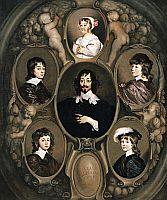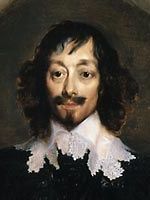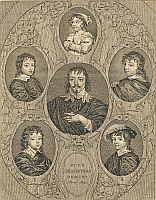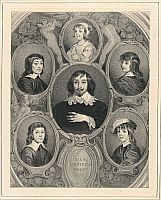Portraits of Constantijn Huygens (1596-1687).
Portraits made during Constantijn's life time.
- Collar types
- 1622-1632 stiff circular collars are worn,
- 1635-1647 lace collars with elaborate fringes (aka Van Dyck collars) appear
Notice that e.g. in the paintings that Rembrandt made in 1632 of Maurits Huygens and Jacques de Gheijn, Huygens wears a lace collar with fringes while De Gheijn still wears the classic model. Also in The Anatomical lesson of dr Tulp that was painted that same year an assortment of different collars is onm display. A portrait by Thomas de Keyzer made in 1632 also shows a lace collar with elaborate fringes.
- 1647- these fringes disappear and are replaced by decorative tassels under the collar. Gradually the front of the collar increases in size (or so it seems).
- Hear / Head gear
- 1622-1625 Huygens has his hair combed back,
- 1625-1630 keeps his hair hidden under a hat
- 1631-1635 his hair reappears much thinner showing his forehead until in
- 1635-1687 Huygens has his hair combed forward.
- 1639-1687 Huygens starts wearing a skull cap in until the end of his life.

 1622 self portrait (9 * 6.3 cm., silverpoint on parchement). Present location unknown.
1622 self portrait (9 * 6.3 cm., silverpoint on parchement). Present location unknown.Londini, Junis
1622.
|
Nemo Dissimilem proprio conamine vultum Increper, heu! paucis adeo, quo aequus amavit Juppiter, innotuisse ferunt GNWQI SEAUTWN S. |

 1625 (14 * 11.5 cm.) Michael Jzn. Mierevelt (1567-1641) / engraving W. van Delff (1580-1638).
1625 (14 * 11.5 cm.) Michael Jzn. Mierevelt (1567-1641) / engraving W. van Delff (1580-1638).The Aº Diii MDCXXV is inconsistent with the Aetat. XXVII suggesting that the original was painted around 1623. A smaller version (10 * 8 cm.) appeared in the first edition of the Otiorum libri XI published in 1625 by Arnold Meurs.

 1626/7 (99 * 84 cm., oil on wood) Jan Lievens (1607-1674), Collection Musée de la Chartreuse, Douai on a long term loan to the Rijkmuseum, Amsterdam (signature: SK-C-1467).
1626/7 (99 * 84 cm., oil on wood) Jan Lievens (1607-1674), Collection Musée de la Chartreuse, Douai on a long term loan to the Rijkmuseum, Amsterdam (signature: SK-C-1467).Discovered in 1935. On April 5, 1632 Huygens writes the following poem:
|
IN EFFIGIEM MEAM, MANU I. LIVII Picturae nec lingua deest, ne fallere, nec vox; Hugenii facies haec meditantis erat. Si quaeras animam, spirantem quisque videbis, Qui attuleris qualem Livius intuitum. |

 1627 (92.4 * 69.3 cm., oil on wood) Thomas de Keyzer (1596/7-1667), The National Gallery, London.
1627 (92.4 * 69.3 cm., oil on wood) Thomas de Keyzer (1596/7-1667), The National Gallery, London.

 1632/1645 (24.5 * 17.1 cm., engraving) painting A van Dijck (1599-1541, Ant. van dyck pinxit) / engraving by Paulus Pontius (1603-1658, Paul. Ponsius Sculp.).
1632/1645 (24.5 * 17.1 cm., engraving) painting A van Dijck (1599-1541, Ant. van dyck pinxit) / engraving by Paulus Pontius (1603-1658, Paul. Ponsius Sculp.).The engraving is part of collection of portraits that was first issued in 1645 under the title Iconographia. The portraits however were of a much earlier date. On January 28, 1632 Huygens notes: 'Pingor a Van Dyckio, cum arbor in aedes lapsus esset'.
On March 11, 1632 Huygens wrote three poems:
|
IN LIBROS ICONUM ILLUSTRIUM VIRORUM ANTON: DYCKII Vivitur ingenio: servat cum vertice dextras Dyckius, et, sunto caetera mortis, ait. IN MEAM IBIDEM EFFIGIEM Hugenium illustres inter mirare? necesse His umbris lucem quae daret umbra fuit. IN IPSIUS DYCKII EFFIGIEM Os aliquis frontem atque oculos imitarier aude Dycki, nemo manum non imitabilem. |
 1632/1664 (10.0 * 9.2 cm., engraving (trimmed)) painting A van Dijck (1599-1541, A van Dyck pinxit.) / engraving by Richard Gaywood (1603-1658, R. Gaywood fecit 1664.). British Museum London
1632/1664 (10.0 * 9.2 cm., engraving (trimmed)) painting A van Dijck (1599-1541, A van Dyck pinxit.) / engraving by Richard Gaywood (1603-1658, R. Gaywood fecit 1664.). British Museum London
 1635 (98 * 82 cm., oil on canvas) by Jacob van Campen (1595-1657). Mauritshuis, The Hague.
1635 (98 * 82 cm., oil on canvas) by Jacob van Campen (1595-1657). Mauritshuis, The Hague.
 1639 (23.8 * 17.4 cm., Black chalk on paper) by Jan Lievens (1607-1674, IL). British Museum, London.
1639 (23.8 * 17.4 cm., Black chalk on paper) by Jan Lievens (1607-1674, IL). British Museum, London.
 1639 (26 * 19 cm., engraving) drawing by Jan Lievens (1607-1674, Ioannes Livius delin.) / engraving by Lucas Vorsterman (1595?-1675?, Lucas Vorstermans sculpsit).
1639 (26 * 19 cm., engraving) drawing by Jan Lievens (1607-1674, Ioannes Livius delin.) / engraving by Lucas Vorsterman (1595?-1675?, Lucas Vorstermans sculpsit).Nicolaes Heinsius wrote a four line poem:
|
Hic ille Auriacis Hugenius inclytus actis Effigies patriae primaque fama suae Omnibus hunc terris ostende batavia vultu**? Qui toto vultus monstrat in orbe tuos |
| Nic: Heinsius, D. F. |

 1639/40, (206 * 174.5 cm, oil on canvas) of Constantijn Huygens and his children by
Adriaen Hanneman (1604-1671). Mauritshuis, The Hague.
1639/40, (206 * 174.5 cm, oil on canvas) of Constantijn Huygens and his children by
Adriaen Hanneman (1604-1671). Mauritshuis, The Hague.Formerly the boy on left of Constantijn sr was 'recognized' as Christiaan. However the place on the right of a father, which to the viewer is the left side, was traditionally reserved for the eldest son i.e. Constantijn jr.. This meant that the son on his left (his right side to the viewer) had to be Christiaan. The empty medallion at the bottom contains the text
HÆREDITAS
DOMINI.

 1641 (72 * 57 cm., oil on canvas) Michael Jzn. Mierevelt (1567-1641). Museum Hofwijck, Voorburg.
1641 (72 * 57 cm., oil on canvas) Michael Jzn. Mierevelt (1567-1641). Museum Hofwijck, Voorburg.
 1646 (58 * 74 cm., oil on panel) by Jan Mijtens (1614-1670). Musee des Beaux-Arts, Rennes.
1646 (58 * 74 cm., oil on panel) by Jan Mijtens (1614-1670). Musee des Beaux-Arts, Rennes.This group portrait represents the wedding of princess Louise Henriette daughter of Frederick Hendrik (stadholder) and Frederick Willem van Brandenburg. The wedding was held in The Hague in the old palace. Huygens probably is among the persons depicted as he was involved in the proceedings as well as in drawing up the marriage contract. (OC 18a, November 26, 1646).

 1647 (34.2 * 38.9 cm., engraving) by Adriaen Pietersz. van de Venne (1589-1662, pinxit) / engraving by Cornelis van Dalen (1602-1665, sculpsit).
Dodelycke Uytgang van Syn Hoogheyt Fred. Hendrik Prince van Oranje. (on the banner above the scene). Constantijn Huygens is portrayed (as nr 15) at the left with a small boy hiding behind him.
1647 (34.2 * 38.9 cm., engraving) by Adriaen Pietersz. van de Venne (1589-1662, pinxit) / engraving by Cornelis van Dalen (1602-1665, sculpsit).
Dodelycke Uytgang van Syn Hoogheyt Fred. Hendrik Prince van Oranje. (on the banner above the scene). Constantijn Huygens is portrayed (as nr 15) at the left with a small boy hiding behind him.
 1651 Medallion (58 * 38 cm, marble) by François Dieussart (). Gemeente Museum, The Hague; on loan in Museum Hofwijck, Voorburg.
1651 Medallion (58 * 38 cm, marble) by François Dieussart (). Gemeente Museum, The Hague; on loan in Museum Hofwijck, Voorburg.

 1655 (9.5 * 7.5 cm, engraving) by Adriaen Hanneman? (1604-1671) / engraving by Jonas Suyderhoeff (1614-1686).
1655 (9.5 * 7.5 cm, engraving) by Adriaen Hanneman? (1604-1671) / engraving by Jonas Suyderhoeff (1614-1686).Appeared in the second edition of the Momenta desultoria; poëmatum libri XIV published in 1655 by Adriaen Vlacq. Van Gelder suggests that the orginal by Hanneman dates from 1648.

 1657 (19.5 * 16 cm. engraving) drawing by Chr. Huygens (delineavit) / engraving by Cornelis Visscher (1629-1658, sculpsit).
1657 (19.5 * 16 cm. engraving) drawing by Chr. Huygens (delineavit) / engraving by Cornelis Visscher (1629-1658, sculpsit).Appeared in first edition the Koren-Bloemen published in 1658, edited by Christiaan Huygens.

 1665 (44.7 * 33.2 cm.) Crispijn van de Passe.
1665 (44.7 * 33.2 cm.) Crispijn van de Passe. Sinne-beeld. Ter eeren van Sijn Doorluchtighste Hoogheyt Willem de III. A second version was issued in which the painting of the Willem III was transformed into a painting symbolizing the seven provinces.

 1672 (27 * 23 cm. oil) by Caspar Netscher (1639-1684), Rijkmuseum, Amsterdam (signature: SK-A-292 ); on long term loan to Museum Hofwijck, Voorburg.
1672 (27 * 23 cm. oil) by Caspar Netscher (1639-1684), Rijkmuseum, Amsterdam (signature: SK-A-292 ); on long term loan to Museum Hofwijck, Voorburg.

 1675? (23.3 * 35.6 cm. coloured drawing) by Frederik de Moucheron? (1633-1686), Museum Hofwijck, Voorburg. Both date (probably later?) and artist (another Moucheron?) seem to be lately in a state of flux.
1675? (23.3 * 35.6 cm. coloured drawing) by Frederik de Moucheron? (1633-1686), Museum Hofwijck, Voorburg. Both date (probably later?) and artist (another Moucheron?) seem to be lately in a state of flux.

 1686 (34.5 * 25.7 cm. mezzotint) by Bernard Vaillant (1632-1698)/ Abraham Blooteling (1640-1690).
1686 (34.5 * 25.7 cm. mezzotint) by Bernard Vaillant (1632-1698)/ Abraham Blooteling (1640-1690).Huygens wrote on Februari 17, 1686 two poems:
|
IN EFFIGIEM EX ARTE QUAM NIGRAM VOCANT Aut penicillo Pictor, aut Sculptor stilo Exercet Artem, quâ sumus bis, qui sumus, Et aere fuso vivimus perennius: Nec Penicillo hic, nec Stilo, artifex nouus (5) Idem peregit. ecce spirat ut loqui Imago muta gestiat. quid relliquum est? Nisi ut sinistrâ ac dextrâ mutili manu Vel solâ agamus voce, vel nutu deos. IN EFFIGIEM MEAM Hugenius Constantinus Zulichemius hic est: Magna vides, Lector, nomina, rem nihili. |
Posthumous representations.

 1732 - 1771 (11 * 9.5 cm., oil on copper) by Jan Maurits Quinkhard (1688-1772) after Paulus Pontius, Rijkmuseum, Amsterdam (signature: SK-A-4570)
1732 - 1771 (11 * 9.5 cm., oil on copper) by Jan Maurits Quinkhard (1688-1772) after Paulus Pontius, Rijkmuseum, Amsterdam (signature: SK-A-4570)

 1817, (14 x 11 cm, engraving + etching) drawing by N.I.W.C.Heideloff (1761-1837)/etching and engraving by P.H.L. v.d. Meulen (1780-1850).
1817, (14 x 11 cm, engraving + etching) drawing by N.I.W.C.Heideloff (1761-1837)/etching and engraving by P.H.L. v.d. Meulen (1780-1850).The print appeared in Peerlkamp's edition of Constantijn Huygens Sermones de Vita Propria. It copies the painting by Hanneman, that according to the text on the print, was by P. van Dijk. Numbers are added to the portraits of the children (1 top = Suzanne, 2 middle-left = Constantijn, 3 middle-right = Christiaan, 4 bottom-left = Lodewijk, 5 bottom-right = Philips). A poem by Constantijn Huygens dated Jan 3, 1641 is added.
|
Quo genus et formam Constanter, opesque et amoris Imtempestivi spernat ubique faces, Hugenium divâ privatum Conjuge Patrem Hoc armaverunt Fata satellitio |
Source: collection G.M. Duijvestein, Voorburg.

 1840, (15 x 18 cm, lithography) by F.B Waanders (1809-1880) / lithography by C.M. Mensing.
1840, (15 x 18 cm, lithography) by F.B Waanders (1809-1880) / lithography by C.M. Mensing.Taken from the first volume of the the art journal 'De Kunstkronyk' (1840-1841). It copies the painting by Hanneman, that according to the text on the print, was at that time attributed to A. van Dijk. See also entry 1817.
Source: collection G.M. Duijvestein, Voorburg.

 1897 (h? * b? cm., bronze (statue) and stone (base)) by A.W.M. Od? (1865-1955). Signed: "A.W.M. Odé jnv.".
Was originally located at the corner of the Scheveningseweg and the Verhuëllweg (now professor B.M. Teldersweg).
Was removed during WWII and was in June 1953 relocated to the Ary van der Spuyweg in The Hague.
1897 (h? * b? cm., bronze (statue) and stone (base)) by A.W.M. Od? (1865-1955). Signed: "A.W.M. Odé jnv.".
Was originally located at the corner of the Scheveningseweg and the Verhuëllweg (now professor B.M. Teldersweg).
Was removed during WWII and was in June 1953 relocated to the Ary van der Spuyweg in The Hague. Inscription at the front of the base.
HUYGENS
1596-1687

 1928 J. H. Isings (), Een zomermiddag met de Muiderkring (1628)
1928 J. H. Isings (), Een zomermiddag met de Muiderkring (1628)Huygens' head seems to be derived from the 1625 Mierevelt portrait with a little goattee from the 1627 Thomas de Keyzer portrait. The collar seems to be incorrect, as this type was not yet around in 1628.

 1996, (h? * b?, bronze) by Hans Bayens (1924-2003). Constantijn en Christiaan Huygens. Park Vreugd en Rust. Voorburg.
1996, (h? * b?, bronze) by Hans Bayens (1924-2003). Constantijn en Christiaan Huygens. Park Vreugd en Rust. Voorburg.To commemorate the tricentenary of Christiaan's death (1695) and the quadricentenary of Constantijn sr's birth (1596), in Voorburg a foundation was formed. It was this foundation that commissioned this National Huygens monument. Afterwards it also instituted the annual 'Christiaan Huygens Award'.

 1996, (33 mm, silver) by Willem J. Vis (fish beneath '87' obverse).
1996, (33 mm, silver) by Willem J. Vis (fish beneath '87' obverse).To commemorate the quadricentenary of Constantijn sr's birth (1596) a silver 20 Euro coin was issued. It shows Huygens (based on the 1641 Mierevelt painting) with a goose quill and a musical key refering to his literary and musical talents, the country estate Hofwijck and a ship that is copied after 'de Zeven Provinci?n' the flagship of Michiel de Ruyter. The ship alludes both to Huygens diplomatic travels and to 'Het schip van Staat' as mentioned in Huygen's Scheepspraet. Huygens coins of 5, 10, 50 and 100 Euro were also issued.